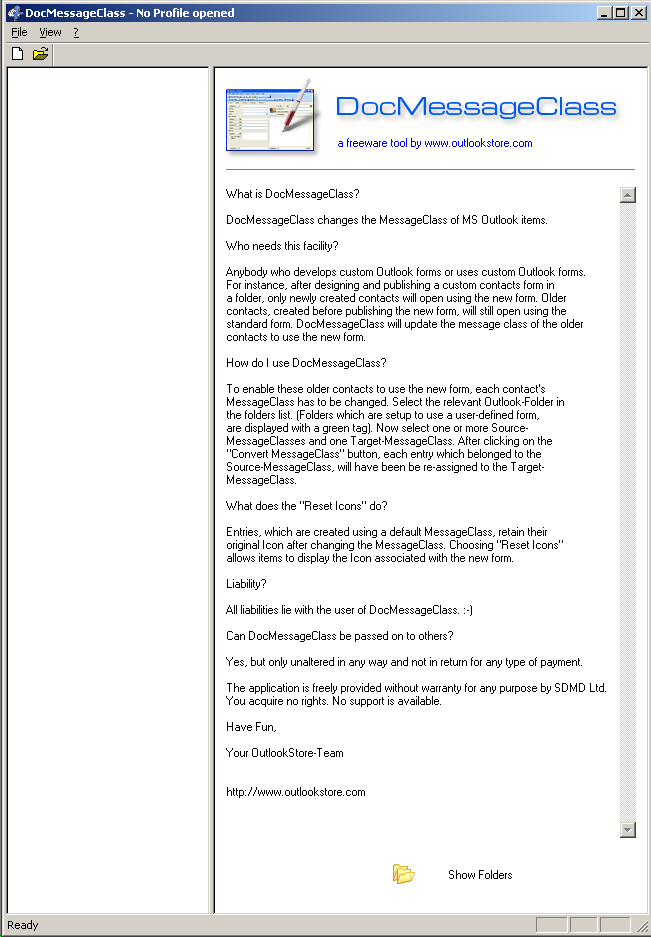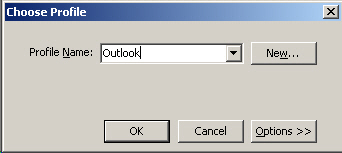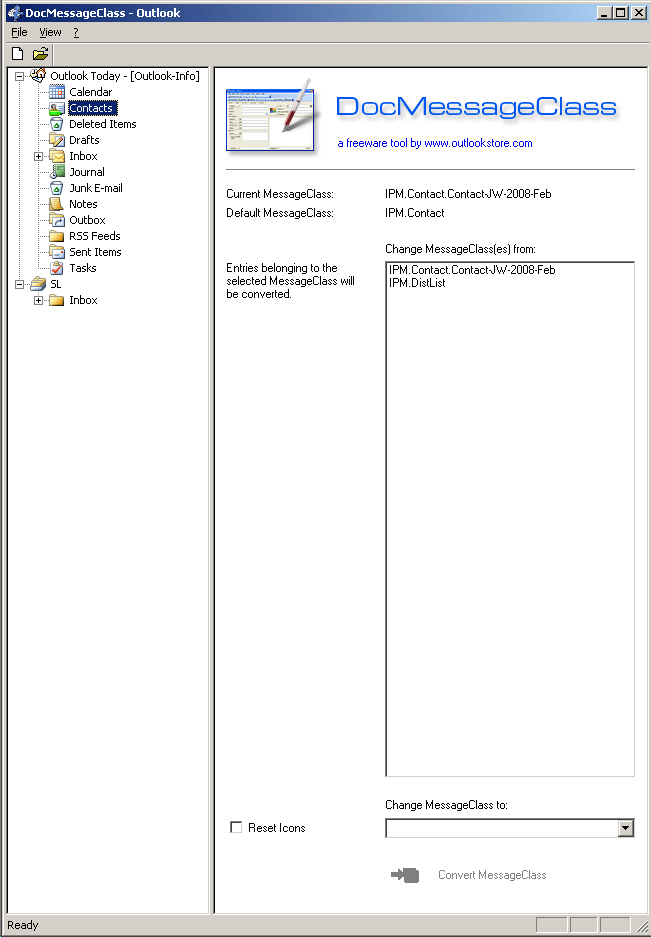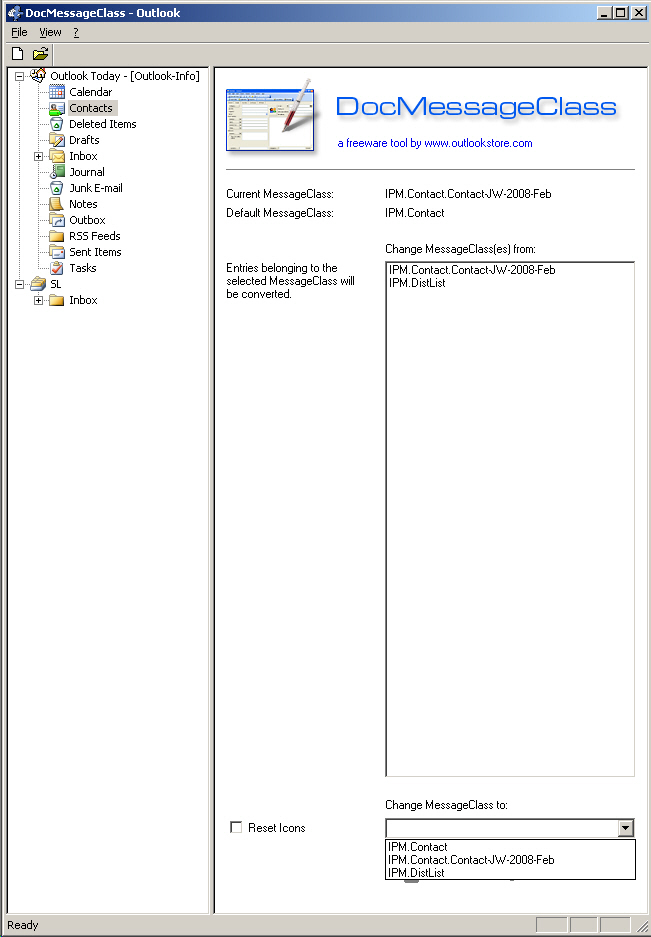Mass Change Outlook Contacts to Use a New Form
50+ years in computers
EE FELLOW 2017 — first ever recipient of Fellow award
MVE 2015,2016,2018
CERTIFIED GOLD EXPERT
DISTINGUISHED EXPERT
EE FELLOW 2017 — first ever recipient of Fellow award
MVE 2015,2016,2018
CERTIFIED GOLD EXPERT
DISTINGUISHED EXPERT
Published:
Browse All Articles > Mass Change Outlook Contacts to Use a New Form
Problem: You created a new custom form in Outlook for your contacts (added fields, deleted fields, changed the layout of fields, whatever) and made it the default form for contacts. The good news is that all new contacts will utilize the new form. The bad news is that all existing contacts will not.
A field in the contact record called Message Class determines which form is used, but the Message Class field cannot be changed manually. The typical approach to solving this problem is to write VBScript code that changes Message Class to the new form for all items in the folder. Examples of this approach may be found in the Microsoft Knowledge Base (How to update existing items in an Outlook folder to use a new custom form) and here at Experts Exchange (Changing Message Class and Journal Values Programmatically). However, many users don't have the skills to deal with VBScript code and add it to Outlook Macros (or are reluctant to do so).
Solution: I had this problem myself, as I wanted to change more than 2,000 contacts to use a new form. I found an excellent, free, out-of-the-box application to do this and wrote this article to share the solution with the Experts Exchange community. There is no VBScript code and no changes to Outlook's Macro handling (in fact, no changes to Outlook at all). You simply run a program (no installation/setup necessary – just run the EXE).
The program is called DocMessageClass (the executable is DocMessageClass.exe), and it is freeware. It provides an easy-to-use, intuitive interface. Here's the opening screen:
![Opening screen]()
After clicking the Show Folders icon, it asks you to select the profile (which, in most cases, is Outlook, and it is typically the only profile):
![Select a profile]()
The program then shows your Outlook folders in the left pane:
![Outlook folders]()
You now click on the Contacts folder and it displays a box that says Change MessageClass(es) from: in which it shows all of the existing Message Class(es) in that folder:
![Change Message Class(es) FROM]()
Since I captured these screens after the actual run of the program, it is now showing only two existing Message Classes, but prior to the run, I had numerous old forms associated with Contacts. It allows you to select any of the existing Message Classes for changing, and you may select more than one at a time. In my case, I selected all of them for changing, except distribution lists and, of course, the new form. It also shows a second box that says Change MessageClass to: and it provides a simple drop-down menu so that you may easily select your new form:
![Change Message Class TO]()
There's only one option: Reset Icons. If you enable this option (via the simple check-box shown in the screen shots above), it will change the existing records to display the Icon associated with the new form. This is a very nice feature, because records that were created with a previous form will retain that form's Icon even after changing the Message Class. This option solves that problem, as you can see in my new Contacts list below that now all have the same Icon:
![Contacts with new icon]()
After selecting the Change MessageClass(es) from: and the Change MessageClass to:, and ticking (or not) the Reset Icons option, you simply click the Convert MessageClass icon, which is now activated (previously, it was grayed-out):
![Convert button]()
The program is fast. I didn't time it, but my recollection from a few days ago is that it changed my 2,308 Outlook contacts in a minute or two.
I downloaded the program from:
http://www.plustech.co.uk/Products/downloads/DocMessageClass.zip
Article update 27-July-2013: The link above no longer works. The link below does.
While writing this article, I discovered another version with a later date at:
http://www.publicshareware.com/download/DocMessageClass.zip
I did not try this second one. If an Experts Exchange member tries it, please post your results.
The opening screen of the program (shown above) has Help text and it is everything you need to know (but www.outlookstore.com no longer exists). As the Help text says, the program is free and may be passed on to others, as long as it is unaltered and there is not any type of payment for it. By the way, I used it on Outlook 2007. It is supposed to work on Outlook 97 through 2007. I found no statement about compatibility with Outlook 2010 (article update 27-July-2013: and, of course, no comment about Outlook 2013). If Experts Exchange members try it on Outlook versions other than 2007, please post your results. It goes without saying, but I'll say it anyway: MAKE A COPY OF YOUR OUTLOOK FILE BEFORE RUNNING THE PROGRAM. If something goes awry, you want to be able to restore easily and quickly your original Outlook file.
If you find this article to be helpful, please click the thumbs-up icon below. This lets me know what is valuable for EE members and provides direction for future articles. Thanks very much! Regards, Joe
A field in the contact record called Message Class determines which form is used, but the Message Class field cannot be changed manually. The typical approach to solving this problem is to write VBScript code that changes Message Class to the new form for all items in the folder. Examples of this approach may be found in the Microsoft Knowledge Base (How to update existing items in an Outlook folder to use a new custom form) and here at Experts Exchange (Changing Message Class and Journal Values Programmatically). However, many users don't have the skills to deal with VBScript code and add it to Outlook Macros (or are reluctant to do so).
Solution: I had this problem myself, as I wanted to change more than 2,000 contacts to use a new form. I found an excellent, free, out-of-the-box application to do this and wrote this article to share the solution with the Experts Exchange community. There is no VBScript code and no changes to Outlook's Macro handling (in fact, no changes to Outlook at all). You simply run a program (no installation/setup necessary – just run the EXE).
The program is called DocMessageClass (the executable is DocMessageClass.exe), and it is freeware. It provides an easy-to-use, intuitive interface. Here's the opening screen:

After clicking the Show Folders icon, it asks you to select the profile (which, in most cases, is Outlook, and it is typically the only profile):

The program then shows your Outlook folders in the left pane:

You now click on the Contacts folder and it displays a box that says Change MessageClass(es) from: in which it shows all of the existing Message Class(es) in that folder:

Since I captured these screens after the actual run of the program, it is now showing only two existing Message Classes, but prior to the run, I had numerous old forms associated with Contacts. It allows you to select any of the existing Message Classes for changing, and you may select more than one at a time. In my case, I selected all of them for changing, except distribution lists and, of course, the new form. It also shows a second box that says Change MessageClass to: and it provides a simple drop-down menu so that you may easily select your new form:

There's only one option: Reset Icons. If you enable this option (via the simple check-box shown in the screen shots above), it will change the existing records to display the Icon associated with the new form. This is a very nice feature, because records that were created with a previous form will retain that form's Icon even after changing the Message Class. This option solves that problem, as you can see in my new Contacts list below that now all have the same Icon:
After selecting the Change MessageClass(es) from: and the Change MessageClass to:, and ticking (or not) the Reset Icons option, you simply click the Convert MessageClass icon, which is now activated (previously, it was grayed-out):

The program is fast. I didn't time it, but my recollection from a few days ago is that it changed my 2,308 Outlook contacts in a minute or two.
I downloaded the program from:
http://www.plustech.co.uk/
Article update 27-July-2013: The link above no longer works. The link below does.
While writing this article, I discovered another version with a later date at:
http://www.publicshareware
I did not try this second one. If an Experts Exchange member tries it, please post your results.
The opening screen of the program (shown above) has Help text and it is everything you need to know (but www.outlookstore.com no longer exists). As the Help text says, the program is free and may be passed on to others, as long as it is unaltered and there is not any type of payment for it. By the way, I used it on Outlook 2007. It is supposed to work on Outlook 97 through 2007. I found no statement about compatibility with Outlook 2010 (article update 27-July-2013: and, of course, no comment about Outlook 2013). If Experts Exchange members try it on Outlook versions other than 2007, please post your results. It goes without saying, but I'll say it anyway: MAKE A COPY OF YOUR OUTLOOK FILE BEFORE RUNNING THE PROGRAM. If something goes awry, you want to be able to restore easily and quickly your original Outlook file.
If you find this article to be helpful, please click the thumbs-up icon below. This lets me know what is valuable for EE members and provides direction for future articles. Thanks very much! Regards, Joe
Have a question about something in this article? You can receive help directly from the article author. Sign up for a free trial to get started.


Comments (2)
Commented:
Author
Commented:I'll appreciate it if you take a moment to click the thumbs-up icon under the article, which endorses it (not the icon at this comment, but the one under the article...currently has a 4 in it...hopefully, you'll be #5). Welcome aboard to EE! Regards, Joe